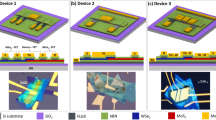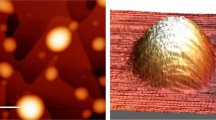Abstract
Atomically thin two-dimensional semiconductors such as MoS2 hold great promise for electrical, optical and mechanical devices and display novel physical phenomena. However, the electron mobility of mono- and few-layer MoS2 has so far been substantially below theoretically predicted limits, which has hampered efforts to observe its intrinsic quantum transport behaviours. Potential sources of disorder and scattering include defects such as sulphur vacancies in the MoS2 itself as well as extrinsic sources such as charged impurities and remote optical phonons from oxide dielectrics. To reduce extrinsic scattering, we have developed here a van der Waals heterostructure device platform where MoS2 layers are fully encapsulated within hexagonal boron nitride and electrically contacted in a multi-terminal geometry using gate-tunable graphene electrodes. Magneto-transport measurements show dramatic improvements in performance, including a record-high Hall mobility reaching 34,000 cm2 V–1 s–1 for six-layer MoS2 at low temperature, confirming that low-temperature performance in previous studies was limited by extrinsic interfacial impurities rather than bulk defects in the MoS2. We also observed Shubnikov–de Haas oscillations in high-mobility monolayer and few-layer MoS2. Modelling of potential scattering sources and quantum lifetime analysis indicate that a combination of short-range and long-range interfacial scattering limits the low-temperature mobility of MoS2.
This is a preview of subscription content, access via your institution
Access options
Subscribe to this journal
Receive 12 print issues and online access
$259.00 per year
only $21.58 per issue
Buy this article
- Purchase on Springer Link
- Instant access to full article PDF
Prices may be subject to local taxes which are calculated during checkout




Similar content being viewed by others
References
Radisavljevic, B., Radenovic, A., Brivio, J., Giacometti, V. & Kis, A. Single-layer MoS2 transistors. Nature Nanotech. 6, 147–150 (2011).
Lee, G. H. et al. Flexible and transparent MoS2 field-effect transistors on hexagonal boron nitride–graphene heterostructures. ACS Nano 7, 7931–7936 (2013).
Mak, K., Lee, C., Hone, J., Shan, J. & Heinz, T. Atomically thin MoS2: a new direct-gap semiconductor. Phys. Rev. Lett. 105, 136805 (2010).
Lee, C. H. et al. Atomically thin p–n junctions with van der Waals heterointerfaces. Nature Nanotech. 9, 676–681 (2014).
Lee, C. et al. Anomalous lattice vibrations of single- and few-layer MoS2 . ACS Nano 4, 2695–2700 (2010).
Kim, S. et al. High-mobility and low-power thin-film transistors based on multilayer MoS2 crystals. Nature Commun. 3, 1011 (2012).
Das, S., Chen, H-Y., Penumatcha, A. & Appenzeller, J. High performance multilayer MoS2 with scandium contacts. Nano Lett. 13, 100–105 (2013).
Baugher, B., Churchill, H., Yang, Y. & Jarillo-Herrero, P. Intrinsic electronic transport properties of high-quality monolayer and bilayer MoS2 . Nano Lett. 13, 4212–4216 (2013).
Radisavljevic, B. & Kis, A. Mobility engineering and a metal–insulator transition in monolayer MoS2 . Nature Mater. 12, 815–820 (2013).
Xiao, D., Liu, G-B., Feng, W., Xu, X. & Yao, W. Coupled spin and valley physics in monolayers of MoS2 and other group-VI dichalcogenides. Phys. Rev. Lett. 108, 196802 (2012).
Mak, K., McGill, K., Park, J. & McEuen, P. Valleytronics. The valley Hall effect in MoS2 transistors. Science 344, 1489–1492 (2014).
Zeng, H., Dai, J., Yao, W., Xiao, D. & Cui, X. Valley polarization in MoS2 monolayers by optical pumping. Nature Nanotech. 7, 490–493 (2012).
Jiang, T. et al. Valley and band structure engineering of folded MoS2 bilayers. Nature Nanotech. 9, 825–829 (2014).
Mak, K., He, K., Shan, J. & Heinz, T. Control of valley polarization in monolayer MoS2 by optical helicity. Nature Nanotech. 7, 494–498 (2012).
Bao, W., Cai, X., Kim, D., Sridhara, K. & Fuhrer, M. High mobility ambipolar MoS2 field-effect transistors: substrate and dielectric effects. Appl. Phys. Lett. 102, 042104 (2013).
Choi, M., Lee, G. H., Yu, Y., Lee, D. & Lee, S. Controlled charge trapping by molybdenum disulphide and graphene in ultrathin heterostructured memory devices. Nature Commun. 4, 1642 (2013).
Wang, H. et al. Integrated circuits based on bilayer MoS2 transistors. Nano Lett. 12, 4674–4680 (2012).
Yu, L. et al. Graphene/MoS2 hybrid technology for large-scale two-dimensional electronics. Nano Lett. 14, 3055–3063 (2014).
Sundaram, R., Engel, M., Lombardo, A. & Krupke, R. Electroluminescence in single layer MoS2 . Nano Lett. 13, 1416–1421 (2013).
Britnell, L. et al. Strong light–matter interactions in heterostructures of atomically thin films. Science 340, 1311–1314 (2013).
Yoon, J. et al. Highly flexible and transparent multilayer MoS2 transistors with graphene electrodes. Small 9, 3295–3300 (2013).
Qiu, H. et al. Electrical characterization of back-gated bi-layer MoS2 field-effect transistors and the effect of ambient on their performances. Appl. Phys. Lett. 100, 123104 (2012).
Kaasbjerg, K., Thygesen, K. & Jacobsen, K. Phonon-limited mobility in n-type single-layer MoS2 from first principles. Phys. Rev. B 85, 115317 (2012).
Ma, N. & Jena, D. Charge scattering and mobility in atomically thin semiconductors. Phys. Rev. X 4, 011043 (2014).
Li, X. et al. Intrinsic electrical transport properties of monolayer silicene and MoS2 from first principles. Phys. Rev. B 87, 115418 (2013).
Novoselov, K. et al. Two-dimensional atomic crystals. Proc. Natl Acad. Sci. USA 102, 10451–10453 (2005).
Kappera, R., Voiry, D., Yalcin, S. E., Jen, W. & Acerce, M. Metallic 1T phase source/drain electrodes for field effect transistors from chemical vapor deposited MoS2 . Appl. Phys. Lett. 2, 092516 (2014).
Guo, Y. et al. Study on the resistance distribution at the contact between molybdenum disulfide and metals. ACS Nano 8, 7771–7779 (2014).
Kappera, R. et al. Phase-engineered low-resistance contacts for ultrathin MoS2 transistors. Nature Mater. 13, 1128–1134 (2014).
Schmidt, H. et al. Transport properties of monolayer MoS2 grown by chemical vapor deposition. Nano Lett. 14, 1909–1913 (2014).
Yu, Z. et al. Towards intrinsic charge transport in monolayer molybdenum disulfide by defect and interface engineering. Nature Commun. 5, 5290 (2014).
Zhu, W. et al. Electronic transport and device prospects of monolayer molybdenum disulphide grown by chemical vapour deposition. Nature Commun. 5, 3078 (2014).
Qiu, H. et al. Hopping transport through defect-induced localized states in molybdenum disulphide. Nature Commun. 4, 2642 (2013).
Wang, L. et al. One-dimensional electrical contact to a two-dimensional material. Science 342, 614–617 (2013).
Roy, T. et al. Field-effect transistors built from all two-dimensional material components. ACS Nano 8, 6256–6264 (2014).
Haigh, S., Gholinia, A., Jalil, R., Romani, S. & Britnell, L. Cross-sectional imaging of individual layers and buried interfaces of graphene-based heterostructures and superlattices. Nature Mater. 11, 764–767 (2012).
Van der Zande, A. M. et al. Grains and grain boundaries in highly crystalline monolayer molybdenum disulphide. Nature Mater. 12, 554–561 (2013).
Du, Y., Yang, L., Liu, H. & Ye, P. Contact research strategy for emerging molybdenum disulfide and other two-dimensional field-effect transistors. APL Mater. 2, 092510 (2014).
Das, S. & Appenzeller, J. Where does the current flow in two-dimensional layered systems? Nano Lett. 13, 3396–3402 (2013).
Liu, H., Neal, A. T. & Ye, P. D. Channel length scaling of MoS2 MOSFETs. ACS Nano 6, 8563–8569 (2012).
Liu, H. et al. Switching mechanism in single-layer molybdenum disulfide transistors: an insight into current flow across Schottky barriers. ACS Nano 8, 1031–1038 (2013).
Fivaz, R. & Mooser, E. Mobility of charge carriers in semiconducting layer structures. Phys. Rev. 163, 743755 (1967).
Chen, J-H., Jang, C., Xiao, S., Ishigami, M. & Fuhrer, M. S. Intrinsic and extrinsic performance limits of graphene devices on SiO2 . Nature Nanotech. 3, 206–209 (2008).
Ando, T., Fowler, A. B. & Stern, F. Electronic properties of two-dimensional systems. Rev. Mod. Phys. 54, 437–672 (1982).
Sarma, D., Adam, S., Hwang, E. & Rossi, E. Electronic transport in two-dimensional graphene. Rev. Mod. Phys. 83, 407–470 (2011).
Neal, A., Liu, H., Gu, J. & Ye, P. Magneto-transport in MoS2: phase coherence, spin–orbit scattering, and the hall factor. ACS Nano 7, 7077–1082 (2013).
Stern, F. & Howad, W. E. Properties of semiconductor surface inversion layers in the electric quantum limit. Phys. Rev. 163, 816–835 (1967).
Novoselov, K. et al. Electric field effect in atomically thin carbon films. Science 306, 666–669 (2004).
Kretinin, A. V. et al. Electronic properties of graphene encapsulated with different two-dimensional atomic crystals. Nano Lett. 14, 3270–3276 (2014).
Liu, G-B., Shan, W-Y., Yao, Y., Yao, W. & Xiao, D. Three-band tight-binding model for monolayers of group-VIB transition metal dichalcogenides. Phys. Rev. B 88, 085433 (2013).
Acknowledgements
This research was supported by the US National Science Foundation (NSF, DMR-1122594), the NSF MRSEC programme through Columbia in the Center for Precision Assembly of Superstratic and Superatomic Solids (DMR-1420634) and in part by the FAME Center, one of six centres of STARnet, a Semiconductor Research Corporation programme sponsored by MARCO and DARPA. G-H.L. was supported by the Basic Science Research Program (NRF-2014R1A1A1004632) through the National Research Foundation (NRF) funded by the Korean government Ministry of Science, ICT and Future Planning, and in part by the Yonsei University Future-Leading Research Initiative of 2014. P.Y.H. acknowledges support from the NSF Graduate Research Fellowship Program under grant DGE-0707428. Additional support was provided through funding and shared facilities via the Cornell Center for Materials Research NSF MRSEC programme (DMR-1120296). C.-H.L. was supported by Basic Science Research Program (NRF-2014R1A1A2055112) through the National Research Foundation (NRF) funded by the Korean Government Ministry of Education, and in part by the Korea Institute of Science and Technology Institutional Program (2Z04490). F.P. and B.S.J. acknowledge support from the Center for Nanostructured Graphene (CNG), which is funded by the Danish National Research Foundation (Project DNRF58). K.W. and T.T. acknowledge support from the Elemental Strategy Initiative conducted by MEXT, Japan. T.T. acknowledges support from a Grant-in-Aid for Scientific Research (grant no. 262480621) and Innovative Areas ‘NanoInformatics’ (grant no. 25106006) from JSPS. The high magnetic field measurements were performed at NHMFL. The authors thank A. Suslov, B.J. Pullum, J. Billings and T. Murphy for assistance with the experiments at NHMFL.
Author information
Authors and Affiliations
Contributions
X.C. and G-H.L. designed the research project and supervised the experiment. X.C., G-H.L., Y.D.K., G.A., C-H.L., F.Y., F.P., B.S.J. and L.W. fabricated the devices. X.C., G-H.L. and Y.D.K. performed device measurements with supervision from P.K. and J.H. X.C., G-H.L., G.A. and X.Z. performed optical spectroscopy and data analysis. D.A.C. grew and prepared the CVD MoS2 sample. T.L. performed theoretical calculations. K.W. and T.T. prepared hBN samples. P.Y.H. and D.A.M. performed TEM analyses. X.C., G-H.L., Y.D.K. and J.H. analysed the data and wrote the manuscript.
Corresponding authors
Ethics declarations
Competing interests
The authors declare no competing financial interests.
Supplementary information
Supplementary information
Supplementary information (PDF 2633 kb)
Rights and permissions
About this article
Cite this article
Cui, X., Lee, GH., Kim, Y. et al. Multi-terminal transport measurements of MoS2 using a van der Waals heterostructure device platform. Nature Nanotech 10, 534–540 (2015). https://doi.org/10.1038/nnano.2015.70
Received:
Accepted:
Published:
Issue Date:
DOI: https://doi.org/10.1038/nnano.2015.70
This article is cited by
-
Lead halide perovskite sensitized WSe2 photodiodes with ultrahigh open circuit voltages
eLight (2023)
-
Approaching the quantum limit in two-dimensional semiconductor contacts
Nature (2023)
-
Highly reproducible van der Waals integration of two-dimensional electronics on the wafer scale
Nature Nanotechnology (2023)
-
Single-material MoS2 thermoelectric junction enabled by substrate engineering
npj 2D Materials and Applications (2023)
-
Superfluid response of an atomically thin gate-tuned van der Waals superconductor
Nature Communications (2023)



